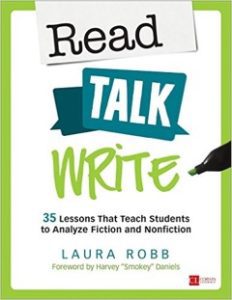The Writing Teacher – Test Prep or Real Writing
We all want our students to love writing and write well. We all want our students to pass our state’s writing test. These two goals create a great tension, and too often, test prep wins out. And so, students write from prompts most of the year. I can’t say this enough: Writing to prompts does not develop writers!
Yes, I want students to become test-wise by experiencing writing to a prompt. If we simulate state test conditions over two days every six weeks, students will gain enough practice. However, to make these simulations benefit students, make a list of areas that need mini-lessons and additional student practice. It could be learning to write a compelling lead or introduction, paragraphing, varying sentence openings, using strong verbs, or specific nouns, etc.
When students apply craft and writing conventions to topics and genres they select, they can grow as writers. Choice leads to students selecting a topic they care about and love. The result is that students are more willing to work hard at improving their writing by investing the time it takes. So, here’s a key point to remember:
Teach students to write well, revise, and edit, and they will pass the test.
Each year that we buy into the pressures of test-prep-writing, we lose multiple opportunities to teach students the craft and art of writing. The caveat is that for teachers to teach writing, they need to do four things:
- Write, Write, Write. This can be objective observations about students, letters to friends and family, a blog, a diary, or journaling about a trip. The point is that by writing, we raise our awareness of the process, and that understanding enables us to support student writers.
- Read professional books and articles on the writing process. Learn what published writers have to say about teaching writing. The more you learn, the better you’ll be able to support your students.
- Read children’s literature so you can develop a bank of mentor texts. Find mentor texts that students can study to deepen their knowledge of genres, leads, endings, uses of dialogue, or how writers handle shifts in time, etc.
- Organize instruction into a workshop and set aside 45-minutes of writing time at least four, preferably five times a week.
Present mini-lessons on writing craft, conventions, and genres. Keep them short and interactive. Keep the workshop authentic by offering students choices. Unlike test-prep writing, students will be at different points in the process. To bring closure to any stage—talking about ideas, brainstorming ideas, planning, drafting—negotiate a deadline date with students.
Professional articles and books will guide your planning of mini-lessons and offer suggestions on modeling and thinking aloud to show students what writers do. Pair-up with a colleague and support each other, observe each other, and you will find that your students will crave more writing time. Most important, allow yourself to make mistakes knowing you can learn from these and give yourself the gift of time as you traverse new paths!
You can learn more about the writing process and teaching writing from Laura Robb’s Heinemann books: Teaching Middle School Writers and Smart Writing: Practical units for Teaching Middle School Writers.
![]()









